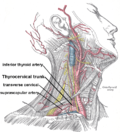Dorsal scapular nerve: Difference between revisions
CSV import Tags: mobile edit mobile web edit |
CSV import |
||
| Line 25: | Line 25: | ||
[[Category:Peripheral nervous system]] | [[Category:Peripheral nervous system]] | ||
[[Category:Anatomy]] | [[Category:Anatomy]] | ||
<gallery> | |||
File:Gray808.png|Dorsal scapular nerve | |||
File:Brachial_plexus.svg|Brachial plexus | |||
File:Brachial_plexus_color.svg|Brachial plexus color | |||
File:Thyrocervical_trunk.png|Thyrocervical trunk | |||
</gallery> | |||
Latest revision as of 04:58, 18 February 2025
Dorsal Scapular Nerve
The dorsal scapular nerve is a peripheral nerve that arises from the brachial plexus, specifically from the root of C5, and occasionally receives fibers from C4 or C6. It is primarily responsible for the innervation of several muscles in the back, including the rhomboid major, rhomboid minor, and the levator scapulae. These muscles play a crucial role in the movement and stabilization of the scapula, thus facilitating shoulder and arm movements.
Anatomy[edit]
The dorsal scapular nerve originates from the brachial plexus, more precisely from the ventral ramus of the fifth cervical nerve (C5). After its origin, it travels medially towards the scalenus medius muscle, passing between this muscle and the scalenus anterior. As it progresses, it moves deep to the levator scapulae and the rhomboids. Unlike most nerves, the dorsal scapular nerve does not pass through the middle scalene muscle.
Function[edit]
The primary function of the dorsal scapular nerve is to innervate the rhomboid major, rhomboid minor, and levator scapulae muscles. The rhomboids are responsible for retracting, elevating, and rotating the scapula downwards, while the levator scapulae elevates the scapula and tilts its glenoid cavity downwards. Through these actions, the dorsal scapular nerve plays a vital role in the movement and stabilization of the shoulder girdle.
Clinical Significance[edit]
- Nerve Entrapment
Dorsal scapular nerve entrapment can lead to pain and dysfunction in the shoulder and scapular region. Symptoms may include a dull ache or severe pain in the upper back, along with weakness or difficulty in moving the shoulder. Diagnosis is often made through physical examination and confirmed with nerve conduction studies.
- Physical Therapy
Treatment for dorsal scapular nerve issues often involves physical therapy, focusing on exercises that stretch and strengthen the shoulder muscles. Postural correction and ergonomic adjustments may also be recommended to alleviate symptoms.
See Also[edit]
-
Dorsal scapular nerve
-
Brachial plexus
-
Brachial plexus color
-
Thyrocervical trunk

